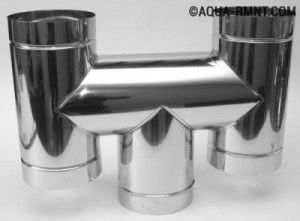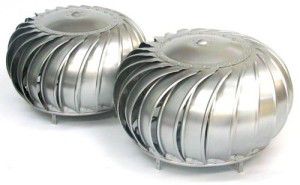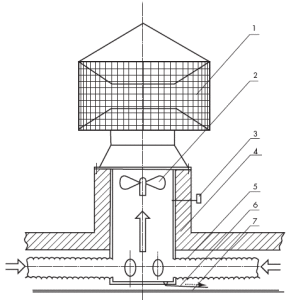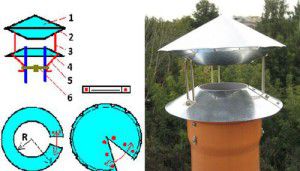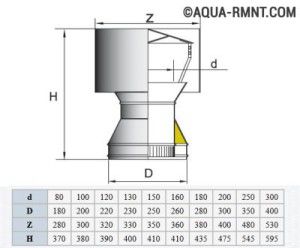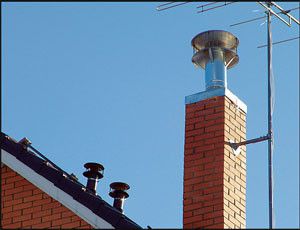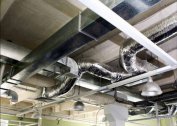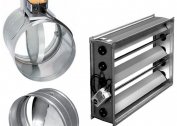Deflectors are mounted on the exits of natural ventilation pipes over the roofs of small enterprises, public buildings, residential buildings. Using the pressure of the wind, the deflectors induce traction in vertical ventilation ducts. The second important function of the deflectors is protection against rain and snow getting into the ventilation shafts. Dozens of models of ventilation deflectors have been developed, some of which are described below. The simplest options for deflectors can be done with your own hands.
Ventilation vent device
Any type of ventilation deflector contains standard elements: 2 glasses, brackets for the cover and nozzle. The outer cup expands downward and the bottom is even. Cylinders are put on each other, a cap is attached above the top. At the top of each cylinder there are rebounds in the form of rings that change the direction of the air in the ventilation deflector of any size.
Outages are set so that the wind on the street creates a suction through the spaces between the rings and accelerates the removal of gases from the ventilation.
The device of the ventilation deflector is such that when the direction of the wind is from below, the mechanism works worse: being reflected from the cover, it is directed towards the gases that go into the upper hole. To a greater or lesser extent, this type of ventilation deflector has this disadvantage. To eliminate it, the lid is made in the form of 2 cones fastened with bases.
When the wind is on the side, the exhaust air is discharged both from above and from below. When the wind is directed from above, outflow occurs from below.
Another device for the ventilation deflector is the same glasses, but the roof is in the shape of an umbrella. It is the roof that plays an important role in redirecting the wind flow.
The principle of operation of the ventilation deflector
The principle of operation of the exhaust ventilation deflector is very simple: the wind strikes into its body, dissects with a diffuser, the pressure in the cylinder decreases, which means that the draft in the exhaust pipe is amplified. The greater the air resistance creates a deflector housing, the better the draft in the ventilation ducts. It is believed that deflectors on ventilation pipes installed slightly tilted work better. The efficiency of the deflector depends on the height above the roof level, size, shape of the body.
The ventilation deflector in winter is frosted on pipes. On some models with a closed housing, frost is not visible from the outside. But with an open zone of the duct, ice appears from the outside of the lower glass and is immediately noticeable.
A properly selected deflector can increase the ventilation efficiency up to 20%.
Most often, deflectors are used in exhaust ventilation of natural draft, but sometimes reinforce forced. If the building is located in areas with rare and light winds, the main task of the device is to prevent reduction or "tipping" of traction.
Types of deflectors
Choosing a ventilation deflector, you can get confused by the variety.
The most common types of ventilation deflectors today:
- TsAGI;
- Grigorovich;
- star-shaped "Shenard";
- ASTATO open;
- spherical "Volper";
- H-shaped.
Plastic ventilation vents are rarely used, as they are short-lived and fragile. Installation of plastic deflectors for ventilation of basements, basements is allowed. Plastic deflectors are widely used only as car accessories.
Some consumers mistakenly call distributors for stretch ceiling ventilation deflectors. Ventilation deflectors are installed only at the ends of the exhaust ducts. Ventilation of exhaust ceilings is provided by diffusers and anemostats, through which air evenly and in the right quantities enters the room.
Baffle ASTATO
A model of a rotating ventilation deflector that uses both mechanical and wind traction. With sufficient wind power, the engine turns off and ASTATO operates on the principle of an exhaust ventilation deflector. An electric motor is launched into the calm, which does not affect the aerodynamics in the ventilation system, but provides sufficient vacuum (no more than 35 Pa).
The electric motor is very economical, it is turned on by a signal from a sensor that measures the pressure at the outlet of the ventilation duct. In principle, for most of the year, the ventilation deflector is powered by wind power. The ASTATO ventilation deflector device includes a pressure sensor and a time relay, which automatically start and stop the engine. If desired, this can be done manually.
Static deflector with ejection fan
The partially rotating ventilation deflector is a novelty that has been operating very successfully for several years. DS vents are installed at the ventilation duct outputs; low-pressure fans with reduced noise emission are located a little lower. The fans are started by a pressure sensor. The glass is made of galvanized steel with thermal insulation. Sound ducts and drainage are brought to it. The entire structure is covered from below by a hinged ceiling.
Wind deflector
The device belongs to the category of active ventilation deflectors. It is rotated by the force of moving air currents. The housing with covers rotates due to the bearing module. During movement between the visors, the wind forms a zone of low pressure. The advantage of this type of ventilation deflector is the ability to "adapt" to any direction of the wind and good protection of the chimney from the wind. The disadvantage of a rotating ventilation deflector is the need to lubricate the bearings and monitor their condition. In severe frosts, the weather vane freezes and poorly performs its function.
Rotary turbine
In calm weather, a turbo deflector for ventilation in the form of a turbine is completely useless. Therefore, rotational turbines are not so widespread, despite the attractive appearance. Install them only in areas with a stable wind. Another limitation is that such a turbo deflector cannot be used for chimneys of solid fuel furnaces, as it can be deformed.
DIY ventilation deflector
Most often, with their own hands for ventilation, a Grigorovich deflector is made. The device is quite simple, and the operation of this type of ventilation deflector is uninterrupted.
To make a DIY Grigorovich ventilation deflector you will need:
- galvanized or sheet stainless steel;
- rivets, nuts, bolts, clamp;
- electric drill;
- scissors for metal;
- scriber;
- ruler;
- pencil;
- compass;
- several sheets of cardboard;
- scissors on paper.
Step 1. Calculation of deflector parameters
At this stage, you need to calculate the dimensions of the ventilation deflector and draw a diagram. All initial calculations are based on the diameter of the ventilation duct.
H = 1.7 x D,
Where N - deflector height,D - diameter of the chimney.
Z = 1.8 x D,
Where Z - cap width
d = 1.3 x D,
d - the width of the diffuser.
On the cardboard, we create a diagram of the elements of the ventilation deflector, and cut it out with our own hands.
If you have no experience in manufacturing deflectors, we recommend working out on a cardboard layout.
Step 2. Making the deflector
We draw a scribe on a sheet of metal patterns and with the help of scissors we get parts of the future device. We connect the parts together with small bolts, rivets or welding. To install the cap, we cut out the brackets in the form of curved stripes. We fix them outside the diffuser, we fasten the return cone to an umbrella. All components are ready, now the entire diffuser is going directly to the chimney.
Step 3. Mounting the deflector
We install the lower glass on the chimney pipe and fasten it with bolts. We put on a diffuser (top glass) on top, clamp it with a clamp, fit the cap to the brackets. The work on creating a ventilation deflector with your own hands is being completed by installing a reverse cone, which will help the device to function even with an undesirable wind direction.
Ventilation deflector selection
Any owner wants to choose a ventilation deflector as efficient as possible.
The best models of exhaust ventilation deflectors are:
- plate TsAGI;
- DS model;
- ASTATO.
The deflector operation during calculations is determined by two parameters:
- discharge ratio;
- coefficient of local losses.
The coefficients depend only on the model, and not on the size of the ventilation deflector.
For example, for DS, the local loss coefficient is 1.4.
The rarefaction coefficient is affected by wind speed.
Calculation of the vent for ventilation type DS.
| Wind speed in km \ h | 0,005 | 0,007 | 0,01 |
| Additional wind pressure, Pa | 11 | 21,6 | 44,1 |
A method has been developed for selecting a ventilation deflector for full wind pressure.
Although ventilation deflectors have been undeservedly forgotten and replaced by umbrellas in recent decades, they are returning today. This is a really inexpensive and effective way to improve the natural ventilation of residential and public buildings.
A clip about a vent deflector-spark arrester and how to choose it:
